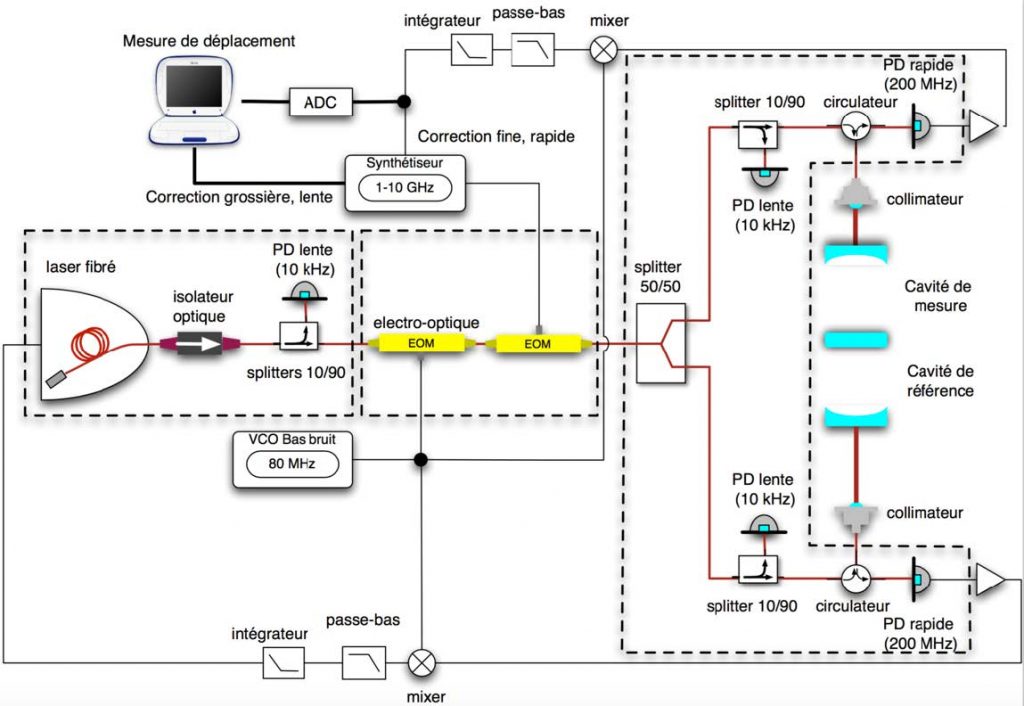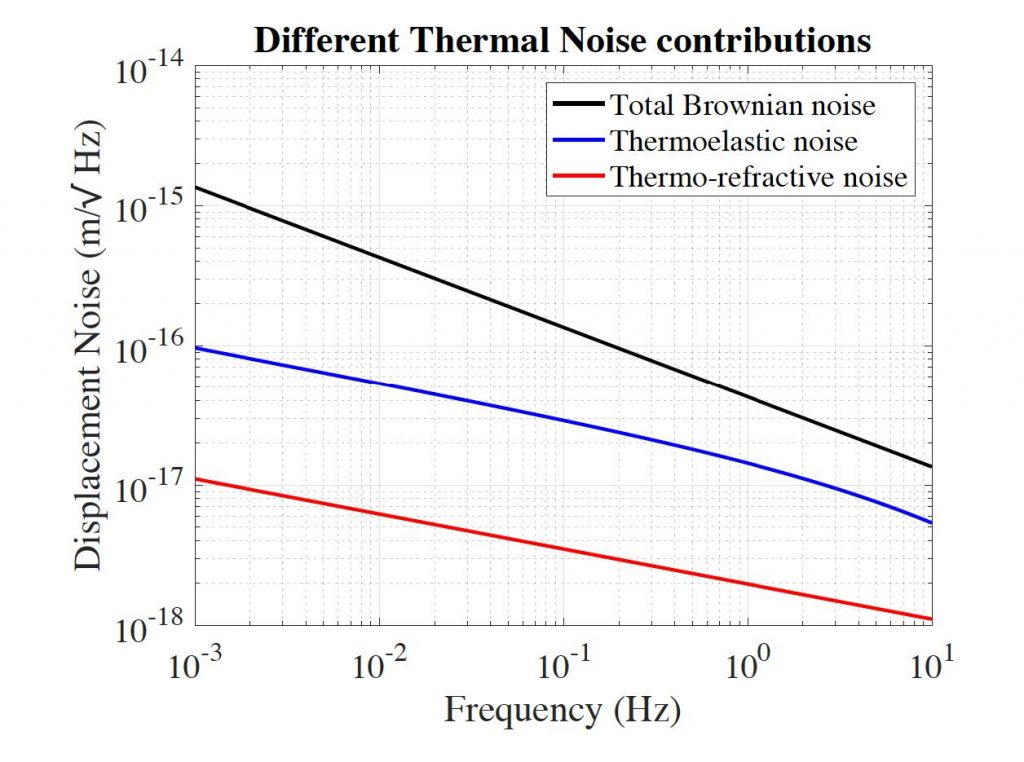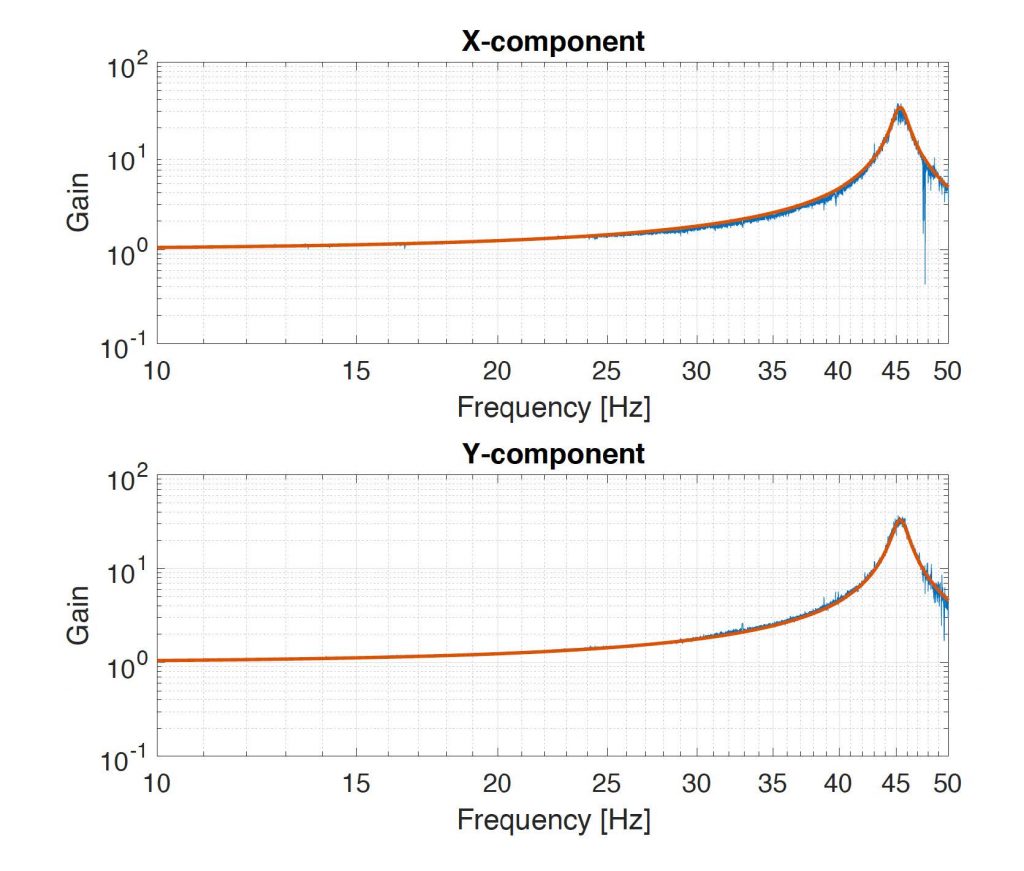I3 : Fundamental physics and Geophysics in space
> Read the articles connected to the project.
-
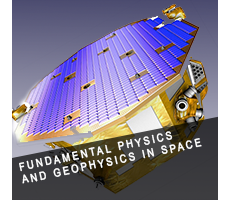 Through the space projects they have been or are pursuing, IPGP and APC have acquired an expertise in precision measurements of distances, times and acceleration in astrophysics, fundamental physics in space, Planetary surface, Earth surface and ocean bottom, as well as a leading role in France in the coordination of missions closely associated to these techniques, e.g. French LISA office (LISA France) and the French Planetary seismometer, selected onboard the NASA/INSIGHT mission.
Through the space projects they have been or are pursuing, IPGP and APC have acquired an expertise in precision measurements of distances, times and acceleration in astrophysics, fundamental physics in space, Planetary surface, Earth surface and ocean bottom, as well as a leading role in France in the coordination of missions closely associated to these techniques, e.g. French LISA office (LISA France) and the French Planetary seismometer, selected onboard the NASA/INSIGHT mission.The techniques involved are necessarily associated with high technology and often extreme precision, requiring unprecedented levels of noise control (often in harsh conditions and measurements at very low frequency) and space-compliant instruments. These techniques represent the path to the future and developing them will allow progress not only in the understanding of the most fundamental aspects of our environment, whether it is the Earth, solar system planets or the Universe at large, but also in the technological prospects for forthcoming space missions. They are indeed closely related with cutting edge knowledge and technologies such as nanotechnologies, high precision distance measurements, solid state physics, etc.
The goal of this WP is to continue R&D efforts in these domains, in order:
- to explore new technologies in acceleration measurements (e.g. with optical or quantum devices, including cold atoms, high temperature superconducting squids and tunneling diodes in the displacement or gravity sensors head, satellite/satellite laser and radio ranging),
- furthermore reduce mass and integrate control electronics (e.g. with the development of Asics, hybrids and highly integrated 3D packaging),
- precisely understand the physics of extremely low thrust engine (e.g. surface and chemical effects of ion sources used for micro-newton thrusters)
- and highly improve insulating structure and packaging by controlling thermal transfers at the nanoscale (e.g. nano thermal coating and micro-design of thermal insulations).
-
Position Name Laboratory Grade & Employer WP leader HALLOIN Hubert APC MCF, Paris Diderot WP co-leader LOGNONNE Philippe IPGP PR, Paris Diderot WP co-leader PLAGNOL Eric APC DR, IN2P3 WP member INCHAUSPE Henri APC Post-Doc, LabEx WP member FAYON Lucille APC / IPGP PhD, Paris Diderot WP member DE RAUCOURT Sébastien IPGP Research Engineer, CNRS -
Two main activities were conducted in this project: the first one on the LISA Pathfinder and LISA missions, the second one on seismometers for planetary missions. These 2 activities are described hereafter. The work performed since the beginning of the LabEx program is described, with an emphasis on the results obtained this last year.
LISA Pathfinder cold gas thrusters and LISA dynamics modelling
Henri Inchauspé successfully defended his thesis in November 2015. Since then and until September 2016, he continued working on LISA Pathfinder and dynamics modeling as a postdoc. Henri obtained a second postdoc position on the MICROSCOPE mission at the ONERA in October 2016 and is since spring 2018 postdoc at the University of Florida in Gainesville, working on the LIGO and LISA projects.
Summary of the thesis / postdoc at the APC (Thesis title : « A noise simulator for eLISA: Migrating LISA Pathfinder knowledge to the eLISA mission ») :
The LISA Pathfinder mission has been launched in December 2015 and until its decommissioning in July 2017 provided valuable information on the technology and performances that will be used for the future LISA mission. It is thus of a great importance to be able to migrate the knowledge acquired from LISA Pathfinder to this future mission,
thus giving the physics community a tool to understand its performances and to suggest possible improvements. The LISA Technology Package (LTP), which is tested during the LISA Pathfinder mission, involves many subsystems as, for example, the micro-propulsion system, the interferometer readout or the controllers.The first results of LISA Pathfinder have been published in Physics Review Letters in June 2016. They demonstrate that the performances observed exceed the requirements of the LISA mission. A number of other articles covering the end of the mission are under internal review in the LPF community and will be published in the following months.
In this context, the most important part of Henri’s work has been to construct a simulator that is able to evaluate the “residual acceleration of the TM” taking into account the perturbations with respect to the “perfect geodesic orbits” that the LISA satellites are meant to follow. An example of results obtained is shown on Figure 1, where the impact of different noise sources on the residual relative acceleration between two S/C (red curve) are shown.
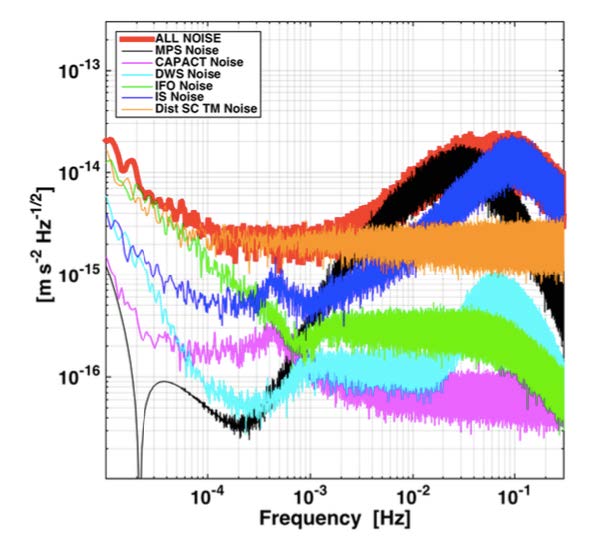
Figure 1 – Residual acceleration noise decomposition, taken from Henri Inchauspé’s thesis (fig 10.23)
Recently, following the selection of the LISA mission by ESA, a strong effort on system simulation has been started. The APC is a major contributor to this project of an ‘end-to-end’ simulator for LISA. In this framework, Henri is helping the LISA community to take over his MATLAB code, so that its algorithms can be reused and implemented
in the simulation software.Henri Inchauspé has successfully defended his thesis in December 2015. An article entitled “LISA Pathfinder drag-free performances: Frequency domain analysis of the in-loop full dynamics of the test masses” has been written and is currently under review by the LPF collaboration. Another article on “Simulation of LISA Dynamics based on LPF results” is being written and shall be submitted for review in the next months.
Work on the Cold Gas thrusters of LISAPathfinder
The APC is in charge of characterizing the performances of the Cold Gas Thruster system of LISAPathfinder. This study has been initiated by H. Inchauspé and continued by J. Martino (research engineer at the APC).
The quantities of particular interest are:
• The noise level of the thrusters noise as a function of frequency
• The determination of the gain and of the direction of individual thrusters.
During LISAPathfinder operations, the thrusters were studied and the following conclusions were made:
• The thrust noise levels were well with the expected values and they had no measurable impact on the measurement of the “Test Masses residual acceleration” even though the later is below the required values for LISA (and the LISA requirements on this quantity are actually 10 times lower than the initial LISA Pathfinder requirements…).
• A number of “sharp” lines were observed around the mHz region. These lines were observed on all thrusters.
• A “common noise”, particularly visible on the thruster force applied on the Z axis (Note: All the 6 thrusters point towards the +Z direction in order to compensate for the solar pressure).
• An analysis of thruster noise indicate that the common noise is of the order of a few 0,1 μN/√Hz and is superimposed on an “individual” noise below 0,1 μN/√Hz for each thruster.
The Figure 2 below shows the force applied by the thrusters on the X, Y and Z axis.
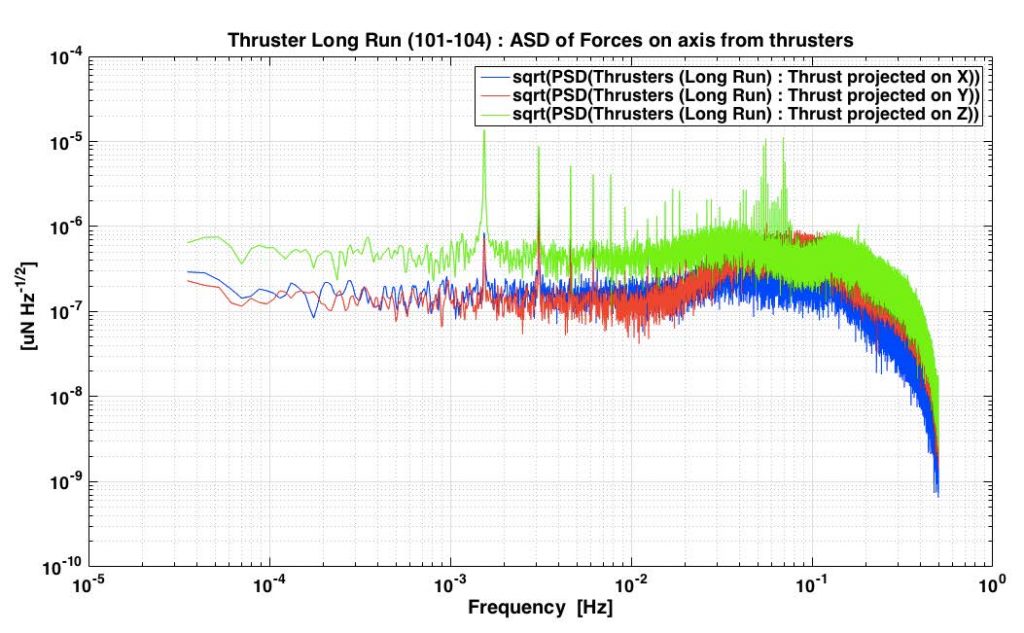
Figure 2 – The projected forces of the thrusters on the X, Y and Z axis. The noise level on the Z axis is due to a “common noise” present on all thrusters. Both this noise and the lines observed on these forces are under investigation
This work was presented in September 2017 in a joint workshop, organized by the CNES, between the LISA Pathfinder and Microscope teams on the specific topic of drag free performance for these two missions. Comparing the results from these two missions – which are using the same cold gas thrusters – allowed identifying a possible source for the extra lines of the LPF data, located in the regulation control of the gas flow fed to the nozzle. This possible explanation is currently under further investigation.
Optical readout for planetary seismometers and mechanical transfer function of VBB seismometers’ leveling system
Since the beginning of the project, an in-depth study of the design and foreseen limiting noise of the readout system has been done. First measurements on a readout prototype have also been performed.
L. Fayon defended her PhD thesis on April 17th 2018 on this work (optical readout system and VBB modeling). Lucile is presently on a postdoc position at the IPGP, preparing for the analysis of the first ‘in-situ’ data from the SEIS instrument (Insight arriving on Mars at the end of November).
Her work on the readout system triggered a H2020 proposal (PIONEERS : Planetary Instruments based on Optical technologies for an iNnovative European Exploration Using Rotational Seismology). In addition to the IPGP, PIONEERS gathers five partners in Europe (France, Germany, Belgium and Switzerland), including a private company (IXBLUE). The aim of this collaboration is to develop high precision interinstruments for measuring ground deformations of planetary objects. The first instrument is a very low noise 6 DoF engineering model dedicated to imaging the internal structure of terrestrial planets. The second one is a high TRL, reduced scale version of the same instrument dedicated to the exploration of small bodies, in order to support planetary defense and asteroid resources application.
The proposal have been accepted in July 2018 and is granted for a duration of 48 months.
We described hereafter that work that has been performed with the support of the LabEx. The proposed optical readout system is based on two Fabry-Perot cavities and the difference of locking frequencies is monitored to deduce the movement of the common mirror (see figure below).Lucile Fayon arrived on this project in october 2014, as a PhD student. During the first year, Lucile mainly had to get familiar with the existing system (laser source and fiber components) and the theoretical bases ruling the locking scheme (Pound-Drever-Hall technique). Extensive tests have been conducted on the laser source to validate its performance. Lucile also had to design and realize the photodiode amplifiers.
The present work is focused on the alignment of the cavity prototype. This alignment turned out to be more complex than expected, partly because of the difficulty of properly measuring the beam shape at the output of the collimator, with our present apparatus.
During the second year, different parameters of the optical cavity (the cavity length, the waist size, the mirrors’ reflectivity, …) were selected, the mechanical cavity was designed and an estimation of different thermal noises, which may affect the performances of the optical cavity, has been also done (see Figure 4).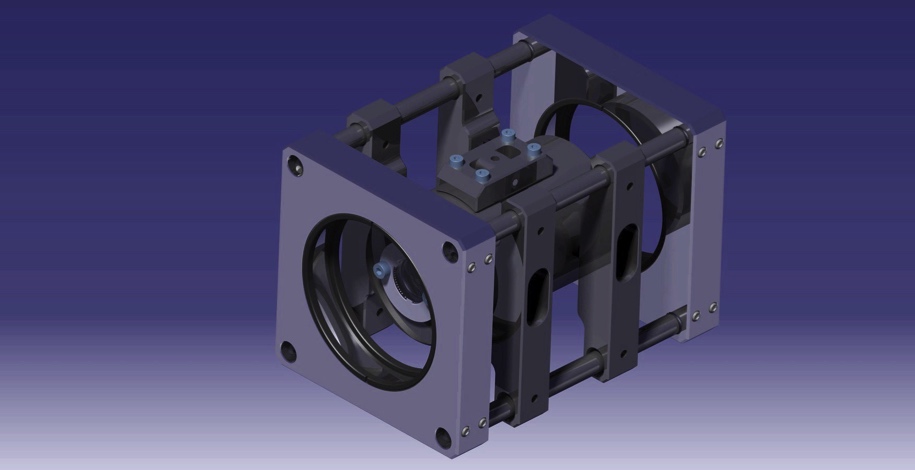
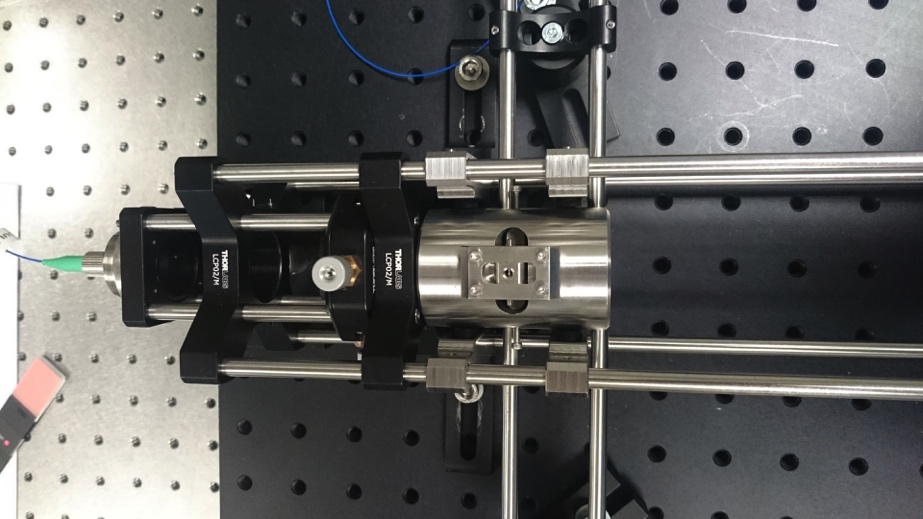 Figure 5 – CAD model and experimental setup of the optical cavity
Figure 5 – CAD model and experimental setup of the optical cavityDuring the third year, the total optical part (for only one cavity) was installed. The Laser beam was first collimated and sent on the central mirror to recover a return signal. Then, the first curved mirror (theand thanks to the piezo) in order to find the resonance (see Figure 5).
Once the optical resonance had been found, the cavity characteristics could checked (and validated) against the optical and error signal models. In order to assess the impact of the temperature fluctuations on the measurement stability, Lucile coupled temperature measurements (in a vacuum chamber representative of ground experiment and predictions for the Martian environment) with a simplified, analytical, thermal model of the cavity. This study demonstrated the importance of common mode rejection due to the symmetric configuration, but also underlined the negative impact of the large thermal inertia of the present Invar prototype on the coupling with temperature gradient noise.
Lucile was also working on the mechanical model of the VBB seismometers’ leveling system embarked on the InSight mission. The objective is to determine the Eigen modes of this structure to see which ones can affect the seismic measurements, and to study the sensitivity of the leveling procedure to some parameters, such as the elastic properties of the Martian ground. Based on the design of the complete SEIS instrument (with the 6 seismic sensors on it), the transfer function of the dynamic system has been coded
under Matlab (see Figure 6).During this last year, this numerical model has been finalized and compared to experimental data, obtained from qualification and flight models. These results were then implemented into the simulations of signals from the penetrator device (HP3 mole) onboard InSight. Based on these simulations, the work performed by Lucile demonstrated that the six seismic sensors (3 VBBs and 3 SPs) within the SEIS instrument will allow disentangling the rotation and translation movements of the leveling system and, therefore, measure the phase velocity of the subsurface Rayleigh waves. An article has just been accepted, in close collaboration with the Max Planck Institute For Solar System Research in Göttingen, in charge of the leveling system.
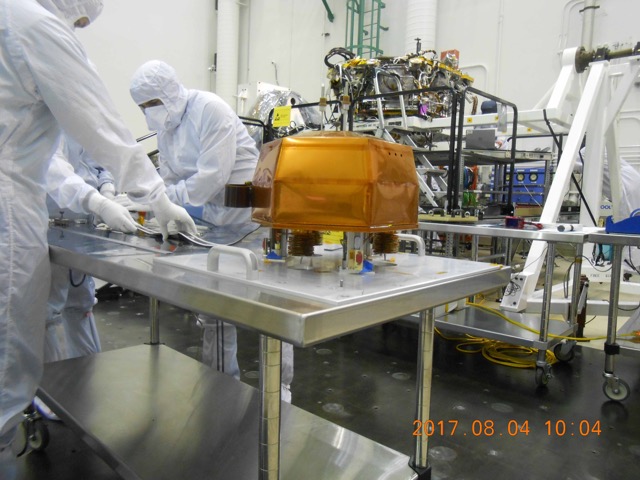
Figure 7 – Picture of the SEIS instrument (foreground) with its 3 support legs (covered with wrinkled dust protections) of the leveling system. The Insight platform is visible in the background.
Lucile presented these different results during her PhD defense, on April 17th, 2018.
-
Fayon et al. A numerical model of the SEIS leveling system transfer matrix and resonances: application to SEIS rotational seismology and dynamic ground interaction, Space Science Reviews, in press
Armano et al., Precision charge control for isolated free-falling test masses: LISA pathfinder results, Phys. Rev. D (2018), vol. 98, pp. 062001
Armano et al., Calibrating the system dynamics of LISA Pathfinder, Phys. Rev. D (2018), vol. 97, pp. 122002
Armano, M. et al. , Beyond the Required LISA Free-Fall Performance: New LISA Pathfinder Results down to 20 μHz, Physical Review Letters (2018), vol. 120, pp. 061101
Armano, M. et al. , Capacitive sensing of test mass motion with nanometer precision over millimeter-wide sensing gaps for space-borne gravitational reference sensors, Physical Review Letters D (2017), vol. 96, pp. 062004
Armano et al. Charge-Induced Force Noise on Free-Falling Test Masses: Results from LISA Pathfinder. Physical review letters (2017) vol. 118 pp. 171101
Armano et al. Constraints on LISA Pathfinder’s self-gravity: design requirements, estimates and testing procedures. Classical and Quantum Gravity (2016) vol. 33 pp. 235015
Nofrarias et al. Optimal design of calibration signals in space-borne gravitational wave detectors. Physical Review D (2016) vol. 93 pp. 102004
Armano et al. Sub-Femto-g Free Fall for Space-Based Gravitational Wave Observatories: LISA Pathfinder Results. Physical Review Letters (2016) vol. 116 pp. 231101
Armano et al. A noise simulator for eLISA: Migrating LISA Pathfinder knowledge to the eLISA mission. Journal of Physics: Conference Series (2015) vol. 610 pp. 012036 [Main author : Henri Inchauspé]
Armano et al. A Strategy to Characterize the LISA-Pathfinder Cold Gas Thruster System. Journal of Physics: Conference Series (2015) vol. 610 pp. 012026
Inchauspe et Plagnol. Migrating LISAPathfinder noise results to the eLISA mission. 40th COSPAR Scientific Assembly. Held 2-10 August 2014 (2014) vol. 40
Without a written acknowledgment of the UnivEarthS Labex support:
Vitale et al. Data series subtraction with unknown and unmodeled background noise. Physical Review D (2014) vol. 90 pp. 042003

